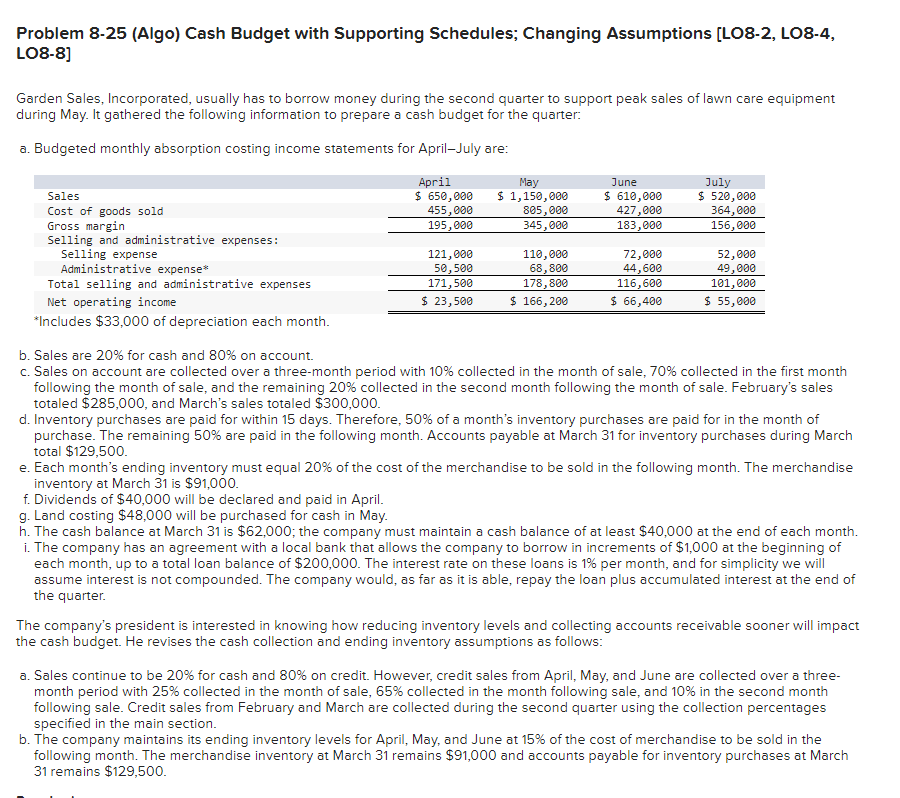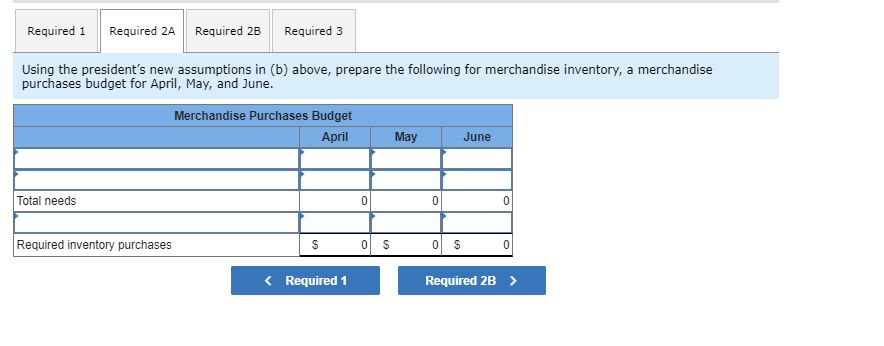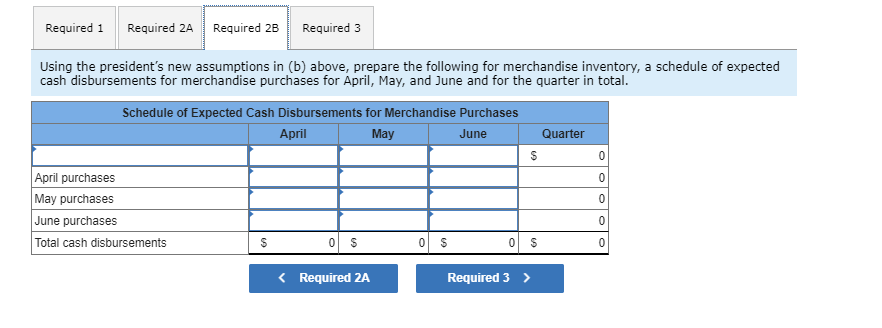Answered step by step
Verified Expert Solution
Question
1 Approved Answer
Using the president's new assumptions in (b) above, prepare the following for merchandise inventory, a merchandise purchases budget for April, May, and June. Using the




 Using the president's new assumptions in (b) above, prepare the following for merchandise inventory, a merchandise purchases budget for April, May, and June. Using the president's new assumptions, prepare a cash budget for April, May, and June, and for the quarter in total. Note: Cash deficiency, repayments and interest should be indicated by a minus sian. Required: 1. Using the president's new assumptions in (a) above, prepare a schedule of expected cash collections for April, May, and June and for the quarter in total. 2. Using the president's new assumptions in (b) above, prepare the following for merchandise inventory: a. A merchandise purchases budget for April, May, and June. b. A schedule of expected cash disbursements for merchandise purchases for April, May, and June and for the quarter in total. 3. Using the president's new assumptions, prepare a cash budget for April, May, and June, and for the quarter in total. Complete this question by entering your answers in the tabs below. Using the president's new assumptions in (a) above, prepare a schedule of expected cash collections for April, May, and June and for the quarter in total. Problem 8-25 (Algo) Cash Budget with Supporting Schedules; Changing Assumptions [LO8-2, LO8-4, LO8-8] Garden Sales, Incorporated, usually has to borrow money during the second quarter to support peak sales of lawn care equipment during May. It gathered the following information to prepare a cash budget for the quarter: a. Budgeted monthly absorption costing income statements for April-July are: b. Sales are 20% for cash and 80% on account. c. Sales on account are collected over a three-month period with 10% collected in the month of sale, 70% collected in the first month following the month of sale, and the remaining 20% collected in the second month following the month of sale. February's sales totaled $285,000, and March's sales totaled $300,000. d. Inventory purchases are paid for within 15 days. Therefore, 50% of a month's inventory purchases are paid for in the month of purchase. The remaining 50\% are paid in the following month. Accounts payable at March 31 for inventory purchases during March total $129,500. e. Each month's ending inventory must equal 20% of the cost of the merchandise to be sold in the following month. The merchandise inventory at March 31 is $91,000. f. Dividends of $40,000 will be declared and paid in April. g. Land costing $48,000 will be purchased for cash in May. h. The cash balance at March 31 is $62,000; the company must maintain a cash balance of at least $40,000 at the end of each month. i. The company has an agreement with a local bank that allows the company to borrow in increments of $1,000 at the beginning of each month, up to a total loan balance of $200,000. The interest rate on these loans is 1% per month, and for simplicity we will assume interest is not compounded. The company would, as far as it is able, repay the loan plus accumulated interest at the end of the quarter. The company's president is interested in knowing how reducing inventory levels and collecting accounts receivable sooner will impact the cash budget. He revises the cash collection and ending inventory assumptions as follows: a. Sales continue to be 20% for cash and 80% on credit. However, credit sales from April, May, and June are collected over a threemonth period with 25% collected in the month of sale, 65% collected in the month following sale, and 10% in the second month following sale. Credit sales from February and March are collected during the second quarter using the collection percentages specified in the main section. b. The company maintains its ending inventory levels for April, May, and June at 15% of the cost of merchandise to be sold in the following month. The merchandise inventory at March 31 remains $91,000 and accounts payable for inventory purchases at March 31 remains $129,500. Using the president's new assumptions in (b) above, prepare the following for merchandise inventory, a schedule of expected cash disbursements for merchandise purchases for April, May, and June and for the quarter in total
Using the president's new assumptions in (b) above, prepare the following for merchandise inventory, a merchandise purchases budget for April, May, and June. Using the president's new assumptions, prepare a cash budget for April, May, and June, and for the quarter in total. Note: Cash deficiency, repayments and interest should be indicated by a minus sian. Required: 1. Using the president's new assumptions in (a) above, prepare a schedule of expected cash collections for April, May, and June and for the quarter in total. 2. Using the president's new assumptions in (b) above, prepare the following for merchandise inventory: a. A merchandise purchases budget for April, May, and June. b. A schedule of expected cash disbursements for merchandise purchases for April, May, and June and for the quarter in total. 3. Using the president's new assumptions, prepare a cash budget for April, May, and June, and for the quarter in total. Complete this question by entering your answers in the tabs below. Using the president's new assumptions in (a) above, prepare a schedule of expected cash collections for April, May, and June and for the quarter in total. Problem 8-25 (Algo) Cash Budget with Supporting Schedules; Changing Assumptions [LO8-2, LO8-4, LO8-8] Garden Sales, Incorporated, usually has to borrow money during the second quarter to support peak sales of lawn care equipment during May. It gathered the following information to prepare a cash budget for the quarter: a. Budgeted monthly absorption costing income statements for April-July are: b. Sales are 20% for cash and 80% on account. c. Sales on account are collected over a three-month period with 10% collected in the month of sale, 70% collected in the first month following the month of sale, and the remaining 20% collected in the second month following the month of sale. February's sales totaled $285,000, and March's sales totaled $300,000. d. Inventory purchases are paid for within 15 days. Therefore, 50% of a month's inventory purchases are paid for in the month of purchase. The remaining 50\% are paid in the following month. Accounts payable at March 31 for inventory purchases during March total $129,500. e. Each month's ending inventory must equal 20% of the cost of the merchandise to be sold in the following month. The merchandise inventory at March 31 is $91,000. f. Dividends of $40,000 will be declared and paid in April. g. Land costing $48,000 will be purchased for cash in May. h. The cash balance at March 31 is $62,000; the company must maintain a cash balance of at least $40,000 at the end of each month. i. The company has an agreement with a local bank that allows the company to borrow in increments of $1,000 at the beginning of each month, up to a total loan balance of $200,000. The interest rate on these loans is 1% per month, and for simplicity we will assume interest is not compounded. The company would, as far as it is able, repay the loan plus accumulated interest at the end of the quarter. The company's president is interested in knowing how reducing inventory levels and collecting accounts receivable sooner will impact the cash budget. He revises the cash collection and ending inventory assumptions as follows: a. Sales continue to be 20% for cash and 80% on credit. However, credit sales from April, May, and June are collected over a threemonth period with 25% collected in the month of sale, 65% collected in the month following sale, and 10% in the second month following sale. Credit sales from February and March are collected during the second quarter using the collection percentages specified in the main section. b. The company maintains its ending inventory levels for April, May, and June at 15% of the cost of merchandise to be sold in the following month. The merchandise inventory at March 31 remains $91,000 and accounts payable for inventory purchases at March 31 remains $129,500. Using the president's new assumptions in (b) above, prepare the following for merchandise inventory, a schedule of expected cash disbursements for merchandise purchases for April, May, and June and for the quarter in total Step by Step Solution
There are 3 Steps involved in it
Step: 1

Get Instant Access to Expert-Tailored Solutions
See step-by-step solutions with expert insights and AI powered tools for academic success
Step: 2

Step: 3

Ace Your Homework with AI
Get the answers you need in no time with our AI-driven, step-by-step assistance
Get Started


